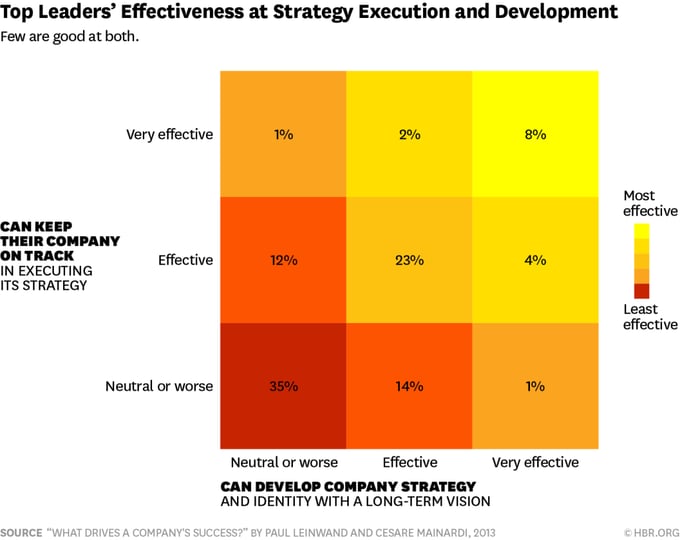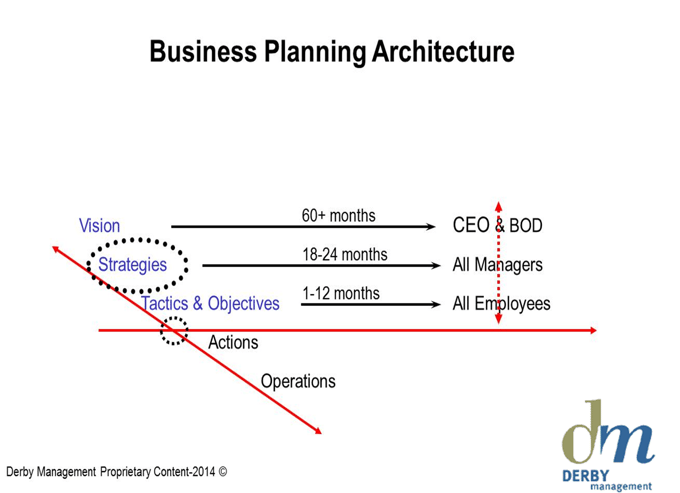One of my new year resolutions from a number of years ago, and one that I highly recommend to everyone now is to subscribe to the Harvard Business Review. Back in the day, when I was in graduate school, I felt that I needed to read the magazines, but with working full time and being married and, and, and...the stacks of unread articles kept growing and weighing down the summer beach bag.
In 2016, with daily access to HBR's very useful blogs and interesting "thoughts-of-the-day", plus the magazine itself (yes, I still get the hard copy), I find that the content is easier to digest, much more pertinent of the real world, and the subscription itself is cheaper. Plus, it's a great source for ebooks, downloads and sourcing for my Tufts alums as they march headlong into the sometimes awkward world of what it takes to be a young supervisor.
This past week, my attention was easily brought to one of their headlines, "Only 8% of Leaders Are Good at Both Strategy and Execution", which I immediately reacted to with... "That can't be right", and "Our customers are much better than that", or so I thought.
THE OPENING PARAGRAPH FROM THE HBR BLOG...
"In a 2013 survey of nearly 700 executives across a variety of industries, our firm asked respondents to rate the effectiveness of the top leaders of their companies. How many excelled at strategy? How many excelled at execution? The results are shown in the chart below. These responses are sobering: Only 16% of top leaders were rated very effective at either strategy or execution. Only 8% were very effective at both, while 63% were rated neutral or worse on at least one dimension"
 Then, they provided this nifty graphic on the left from their survey, which shows the distribution of those execs.
Then, they provided this nifty graphic on the left from their survey, which shows the distribution of those execs.
As they pointed out, "the heartening news is that more than half of the leaders who are effective in either strategy or execution (that group of 16% in the top row and right-hand column) are skilled in both strategy and execution. This finding suggests that among the rest of us, those who become better strategists (those who can develop compelling answers to those fundamental strategic questions) will probably gain skill at execution as well, and vice versa"
At that point, I gave up reading and, first thought through our own strategy customers over the past 10 years of our 25, and took the time and went through each customer making a subjective decision as to which management teams were:
- (1) primarily strategic but only "fair" at tactical execution
- (2) primarily focused at the planning for tactical planning
- (3) primarily focused at not only the tactical planning for execution, but also the execution itself
THE VERY BEST MANAGERS ARE...
 Since we first started the firm, just for simplicity, we created a sine wave and thought about the fact that "our very best managers" were those that could, in an instant and without losing perspective, move from the top of the wave, "the very strategic" to the bottom of the curve, "the very actionable" without skipping a beat.
Since we first started the firm, just for simplicity, we created a sine wave and thought about the fact that "our very best managers" were those that could, in an instant and without losing perspective, move from the top of the wave, "the very strategic" to the bottom of the curve, "the very actionable" without skipping a beat.
 Thinking of a better way to look at this Strategy-to-Tactics-to-Activities Planning Framework, which is the way we always look at our strategic planning process, we then asked which CEO's/Presidents could not only make the journey from Vision to Operations, but they actually enjoy being involved all through the process right down to making the tough choices of activity setting and being involved in the follow up.
Thinking of a better way to look at this Strategy-to-Tactics-to-Activities Planning Framework, which is the way we always look at our strategic planning process, we then asked which CEO's/Presidents could not only make the journey from Vision to Operations, but they actually enjoy being involved all through the process right down to making the tough choices of activity setting and being involved in the follow up.
Assessing approximately 425 companies, our very subjective results are...
- Primarily strategic, and "only fair" at either tactics or activities: 15%
- Primarily focused in the planning for tactics and objective-setting: 70%
- Heavily involved in the tactics, their execution and the activities: 15%
When, we took a look at the same companies not at the CEO, but at "The Top Sales Manager" :
- Primarily strategic, and "only fair" at either tactics or activities: >5%
- Primarily focused at the planning for tactics and objective-setting: 20%
- Primarily focused at both the tactical planning and the execution: 75%
Jack's 6 Rules for 2016 Success in "The Strategy-to-Activities Framework"
- Be Consistent and Develop Your Own Planning Rhythm
The idea of "The Annual Strategy Session" died at least ten years ago. Don't waste your time or money on having the "Our Annual Think Session". Simply don't do it, and don't try to pretend that it's worthwhile...since it's absolutely a total waste of time to have one session per years. More importantly, if you were to take that approach, it will result not only in a lack of agreement among the team, everyone will find that it's simply impossible for a diverse set of team members to reach true consensus through a one session engagement.
Senior managers want consistent strategic involvement throughout the year and "being part of the bigger picture". When there is no formal platform for consistent involvement, or follow up as to an objective assessment and measurement of "What happened?", "How did we measure up?", "How could we have improved"?, and "What strategy worked and what didn't?", then everyone feels cheated. And then they become disillusioned... "Why waste my time!"
A good way to think about 2016 planning would be to commit to a rhythm of one two-day offsite session with four quarterly one-day reviews to assess, tweak, change, openly discuss and argue through decisions to perhaps add more gas to a particular strategy, or to kill a strategy previously agreed on and move on. - Spend Your Time Focusing on the Top Line
As members of the Senior Leadership Team, I'm just going to assume that everyone already knows about "smart revenue", and the obvious management discipline of paying serious attention to gross profit and net income. Since 2008, (and the prior recession...and the recession before that), we've all become experts in cutting expenses, reducing costs and conserving free cash flow.
The same level of expertise does not apply to revenue, where both strategically and tactically, most management teams do not do a very good job at maximizing the productivity of their salespeople. "I've got solid people, but they just need to produce more sales", is the #1 issue for every CEO going into 2016.
If your managers are expert at cutting expenses and solid in Operations, use that same analytical talent of process improvement and the measurement of detailed step points to employ tactics, tools and sales-enabling technologies with your salesforce. With a bit of discipline, the top line will increase dramatically.
2016 is going to be a difficult year, and success will come as a result of growing the top line and not trying to save your way into success. - Inoculate Your Culture into Your Company's DNA
Everyone talks about culture. Some companies, both emerging and enterprise, actually have cultures that have become part of the operating DNA of the business. "Built on Trust" is not only the culture of Reiser, but it's the rally cry; it's the sign on the door; it's the logowear, and it's the #1 process filter through which all customer and employee decisions are made at the company.
Hubspot, is a company we love to use, to talk about and to have my Tufts alums (now 35) work at. Not surprisingly their stated culture of, "Creating a company we love" is passionately explained in this slide deck. That's DNA-embedded culture! - Pick a Future Point and Back into Today
To a large degree, it's unimportant whether that point is in December of 2016, 2017 or 2018. The length of time should only reflect the level of the current stability and growth in your company. In a zero-to-negative growth business, the planning horizon might be six and certainly no more than 12 months. In a moderate growth company, it's appropriate to look out over three years in both six and twelve month increments.
In every case, pick that planning horizon, make sure that everyone is fully bought into that time period, then define your primary objectives that you need to achieve by that time, and then back into today with objectives and tactics.
The rest of the process is the tough stuff of defining and agreeing on the three or four primary future directions (the strategies) that will achieve the biggest growth bang for the buck, and then working through the tactical battle plans that will link into those strategic decision points. Remember, it's just as important in the choosing of new strategies, to make firm decisions to not pursue other strategies that you may have been thinking of.
- Build the Future Team as a Primary Strategic Investment
Maybe this is the team for the next ten years, and, most probably it isn't. Have open discussions with your senior team members and also with your sales managers about succession, no matter what their ages or time in their positions. Things change, and like the best coaches, you need to have clear plans about future draft choices and what happens when someone goes on the Injured Reserve List.
During one of your quarterly strategic planning meetings, which is why there are four quarterly sessions and not three in addition to your two day offsite, have each of the managers present their own succession plan as if they were hit by the proverbial bus or, surprise of surprises, one of them win Saturday's PowerBall.
This is a very important and healthy tactic. Well done, I guarantee you that you will be surprised by the results the first time out! - Take Action on Your Personal Health in 2016
You've heard the phrase... "Nothing counts more than your health"...and, just like your mother might have said "it all goes in one ear, and out the other"... until... you're not healthy.
Each of us have have a strategic choice to make regarding this rule since many chronic diseases can be either avoided completely or dealt with with early detection and better chemistry. We live in a wonderful age of improved cures, life-extending drugs, superb technologies and wonderful docs, so there's zero reason to not pay attention to this 6th Resolution in 2016. As important as your own personal well being, the ramifications of poor health among any of the senior team can have major ramifications on the business.
Best of success, health and happiness in the coming year ! Personally, I am very excited about the year ahead!

Derby Management...for 25 years
-Sales & Marketing Productivity Experts
-Business & Strategy Planning Specialists
-Senior Management Coaches for CEOs & VPs
Box 171322, Boston, MA 02117
Jack's Cell: 617-504-4222

